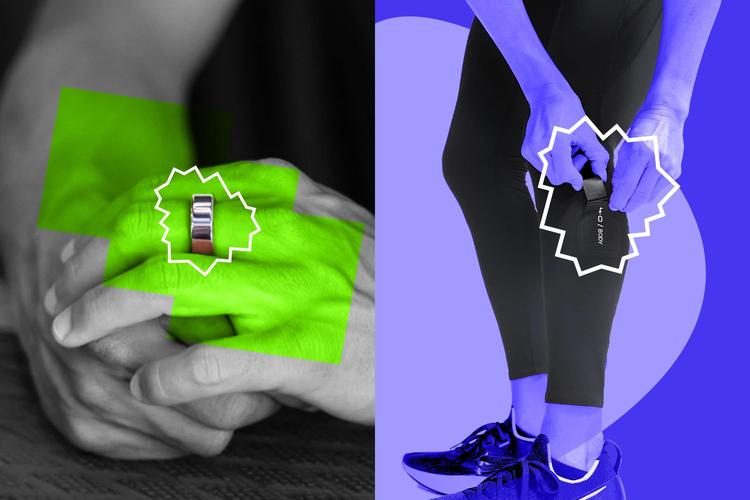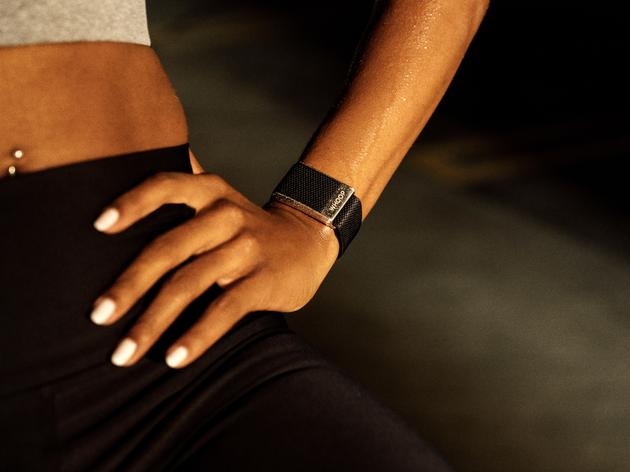
By cuterose
Why some wearable-makers are looking beyond the wrist
The rise of wearables has centered on the wrist, but some companies are targeting other parts of the body.
ByJordan McDonald· 5 min read
Wearables, and digital health tracking in general, have skyrocketed in popularity since the early ’10s, and their rise has largely focused on one specific body part: the wrist.
As of Q3 2021, 56% of wearables were watches or wristbands, per IDC data, which also noted that the Apple Watch alone accounts for over 53% of the wearables market in revenue terms. Over 138 million wearables were shipped in 2021, according to IDC, compared to ~78 million units in 2015.
But a handful of companies, like Whoop, Oura, and Moov, are looking to branch out from the wrist and produce slimmed-down and less noticeable wearables. In part, this is likely an effort to differentiate from the dominant players—or, really, player, in Apple—but the companies also claim that different body placements can yield better tracking for certain goals.
“I definitely see more and more companies that are experimenting in this area,” Nick Babich, design director at product design firm Milkinside, told Emerging Tech Brew. “But in terms of mass consumption…in comparison to smartwatches, I don't see the same number of users for those kind of devices. So we’re probably at the early stages, when our mass audience realizes that they want to switch to those devices.”
The share of wearable devices that are not wrist- or ear-based increased from 7% in Q3 2020 to 12% a year later, per IDC, indicating a greater appetite for different form-factors.
Wearing less, tracking more?
Fitness tracking startup Whoop, which is valued at $3.6 billion, has expanded beyond its original wrist-based design into smart garments. Dubbed Whoop Body, the product is essentially a fitness clothing line, featuring items like compression shorts or bralettes, in which the Whoop 4.0 fitness tracker can be placed. Many of the same metrics tracked by wrist-based wearables—like heart rate and heart variance—are collected, even though the sensors are on different parts of the body.
John Capodilupo, co-founder and chief technology officer at Whoop, told Emerging Tech Brew that some of the best places to get an accurate measurement of heart rate may not be the wrist, bicep, torso, but instead the forehead, ear lobes, and lips. Unfortunately, there’s at least one major problem with that: Design and style preferences may make digital health companies think twice about developing, say, lip rings or headbands that track your heart rate.

Whoop’s smart apparel is an attempt to find a middle ground between form and function. Capodilupo says the clothing line can keep its trackers stable in places that have less motion than the wrist, like the small of the back or torso, leading to more accurate tracking.
“Fundamentally, when you’re not moving at all, most places on the body give a pretty decent signal,” Capodilupo said. “The wrist and the finger are not ideal places by any means, because of all the motion that a human does with those appendages throughout the day. The motion is really what makes getting an accurate heart rate continuously hard.”
Whoop declined to share sales figures for its Body segment, which debuted in September.
Meanwhile, Ōura, a digital health company based in Finland and San Francisco, has taken the mantra of inconspicuousness to an even smaller form, with its Ōura Ring. The health tracker is normally worn on the index finger, and it keeps tabs on metrics like heart rate and heart-rate variability, body temperature, and movement, although its most-marketed use case is sleep tracking.
Jason Russell, director of product at Ōura, told Emerging Tech Brew that the ring’s design emphasizes “being comfortable, being lightweight, being out of the way.”
“It’s not buzzing, it’s not flashing notifications,” he said. “I think I’ve worn watches where the premise was, ‘reduce your screen time by wearing this watch.’...But in my experience, I felt like I’m just bringing more screens into my life.”
In May 2021, Ōura said it crossed the 500,000 mark for units sold of its Ōura Ring product.
Smaller and smaller designs have been enabled by big-picture trends like the miniaturization of semiconductors and of batteries. On that second point, thanks to a new battery partnership with battery startup Sila Nanotechnologies, Whoop was able to make its 4.0 fitness tracker 33% smaller without, it claims, sacrificing battery life.
While moving away from the wrist could allow better applications of certain tech, like heart rate monitors, much of the research around wearables is centered around the wrist, making other parts of the body comparatively uncharted territory.
Plus, the wrist is—in many ways—a functional and familiar place to wear accessories.
As some wearables companies look to venture away from the body part that made wearables a mainstay, Capodilupo envisions a future where wearables are less intrusive—in size and form factor—but more useful in daily life.
“The big area I think is really exciting is as wearables get smaller, and especially as they move throughout the body, is the ability to fuse multiple different sensors together and derive not just double the insights, but exponentially more insights than you would be able to from just having two on your wrist,” Capodilupo said.
Correction: An earlier version of this article incorrectly referred to Ōura as a Boston-based company. We updated this piece on 2/28 to clarify that it is actually based in Finland and San Francisco, we apologize for the error.
The workflow doctor will see you now. A seamless digital experience is what patients have come to expect these days. Contactless scheduling and paperwork, virtual payments, and online sign-in are all processes and workflows Formstack can help you streamline. Don’t let your patients’ patience wear thin—learn more about Formstack today.
Drones, automation, AI, and more. The technologies that will shape the future of business, all in one newsletter.









